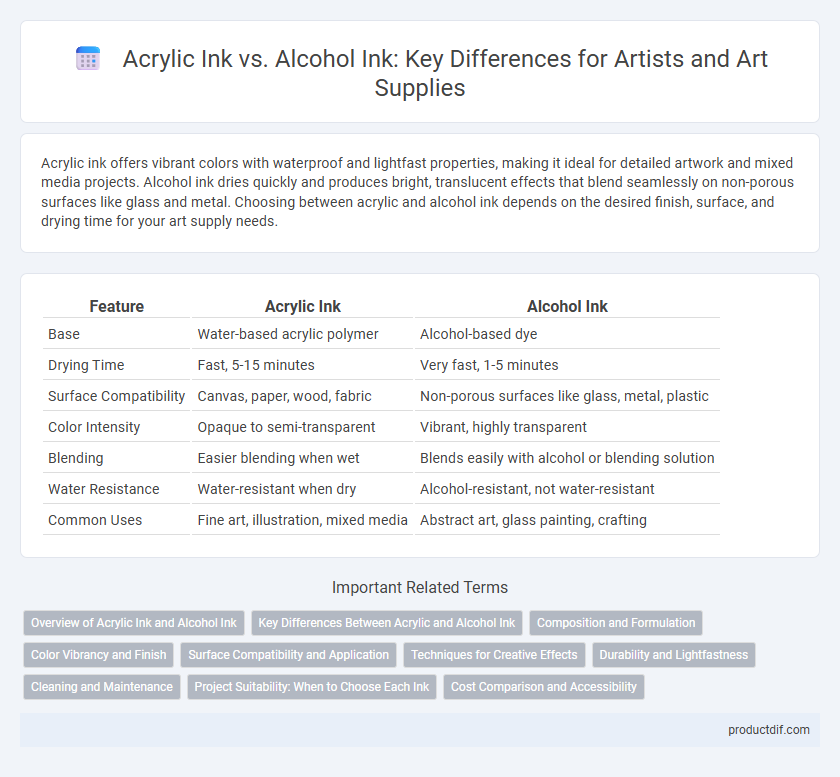Acrylic ink offers vibrant colors with waterproof and lightfast properties, making it ideal for detailed artwork and mixed media projects. Alcohol ink dries quickly and produces bright, translucent effects that blend seamlessly on non-porous surfaces like glass and metal. Choosing between acrylic and alcohol ink depends on the desired finish, surface, and drying time for your art supply needs.
Table of Comparison
| Feature | Acrylic Ink | Alcohol Ink |
|---|---|---|
| Base | Water-based acrylic polymer | Alcohol-based dye |
| Drying Time | Fast, 5-15 minutes | Very fast, 1-5 minutes |
| Surface Compatibility | Canvas, paper, wood, fabric | Non-porous surfaces like glass, metal, plastic |
| Color Intensity | Opaque to semi-transparent | Vibrant, highly transparent |
| Blending | Easier blending when wet | Blends easily with alcohol or blending solution |
| Water Resistance | Water-resistant when dry | Alcohol-resistant, not water-resistant |
| Common Uses | Fine art, illustration, mixed media | Abstract art, glass painting, crafting |
Overview of Acrylic Ink and Alcohol Ink
Acrylic ink is a water-based pigment ink known for its fast drying time, vibrant colors, and strong adhesion to various surfaces, including paper, canvas, and wood. Alcohol ink contains dye-based pigments dissolved in alcohol, offering high fluidity and vibrant, translucent colors that blend seamlessly on non-porous surfaces such as glass, metal, and plastic. Both inks are favored for different artistic techniques, with acrylic ink excelling in opacity and durability, while alcohol ink is prized for its luminous effects and ease of blending.
Key Differences Between Acrylic and Alcohol Ink
Acrylic ink is water-based, offering vibrant colors and durability with quick drying times, while alcohol ink is solvent-based, providing intense, translucent hues that blend seamlessly on non-porous surfaces. Acrylic ink adheres well to a wide range of materials including canvas and paper, whereas alcohol ink is ideal for glossy surfaces like glass, metal, and ceramics due to its fast evaporation and resistance to water. Differences in chemical composition affect drying time, permanence, and surface compatibility, making each ink suited for distinct artistic techniques and project types.
Composition and Formulation
Acrylic ink is water-based, composed primarily of pigment suspended in an acrylic polymer emulsion, which results in a durable, flexible, and waterproof finish once dry. Alcohol ink contains highly concentrated dye dissolved in alcohol, offering fast drying times and vibrant, translucent colors with a fluid, blending behavior on non-porous surfaces. The differing formulations impact their application techniques, adhesion properties, and compatibility with various substrates in art projects.
Color Vibrancy and Finish
Acrylic ink offers intense color vibrancy with a matte or satin finish that remains durable and water-resistant once dry, making it ideal for detailed and layered artwork. Alcohol ink delivers exceptionally bright, translucent colors with a glossy, fluid finish that enhances blending and dynamic effects on non-porous surfaces like glass or metal. Artists often choose acrylic ink for precision and permanence, while alcohol ink excels in creating vibrant, fluid art with luminous, glossy textures.
Surface Compatibility and Application
Acrylic ink adheres well to a variety of surfaces including canvas, paper, and wood, making it ideal for mixed media projects and fine art applications. Alcohol ink is best suited for non-porous surfaces such as glass, metal, and glossy ceramics, producing vibrant, translucent effects that blend smoothly. Surface compatibility directly influences the ink's drying time, durability, and color vibrancy during application.
Techniques for Creative Effects
Acrylic ink offers versatility with layering and blending techniques that produce rich textures and vibrant colors, making it ideal for detailed illustrations and mixed media art. Alcohol ink excels in creating fluid, marbled effects and spontaneous patterns due to its fast-drying and high pigment concentration, perfect for abstract designs and resin art. Mastering techniques like dilution, blending, and surface manipulation enhances creative effects unique to each ink type.
Durability and Lightfastness
Acrylic ink offers superior durability and lightfastness compared to alcohol ink, making it ideal for artworks exposed to sunlight or outdoor conditions. Acrylic ink is water-resistant once dry and resists fading over time, ensuring longevity in fine art and mixed media projects. Alcohol ink, while vibrant and fast-drying, tends to be less lightfast and can fade or change color with prolonged exposure to UV light.
Cleaning and Maintenance
Cleaning and maintenance of acrylic ink require water-based solutions for quick removal before drying, while alcohol ink demands alcohol or specialized cleaners to dissolve pigment residues effectively. Acrylic inks dry into a water-resistant film, making dried stains harder to remove compared to alcohol inks, which remain soluble in alcohol even after drying. Proper cleaning tools such as brushes, cloths, and non-porous palettes enhance maintenance efficiency for both mediums, preserving longevity and color vibrancy.
Project Suitability: When to Choose Each Ink
Acrylic ink is ideal for projects requiring opacity, durability, and vibrant colors on diverse surfaces such as canvas, paper, and wood. Alcohol ink excels in creating fluid, translucent effects on non-porous surfaces like glass, metal, and ceramics, making it perfect for abstract art and decorative items. Choose acrylic ink for precise, layered artwork and alcohol ink for dynamic, flowing designs with intense color blending.
Cost Comparison and Accessibility
Acrylic ink typically offers better cost efficiency, with larger volumes available at lower prices compared to alcohol ink, making it more budget-friendly for artists needing substantial quantities. Alcohol ink tends to be more expensive due to its specialized formulation and vibrant, quick-drying properties, but it is widely accessible in art supply stores and online. Both inks are available in a range of colors and brands, though acrylic ink availability spans more mainstream outlets, enhancing its accessibility.
Acrylic Ink vs Alcohol Ink Infographic

 productdif.com
productdif.com